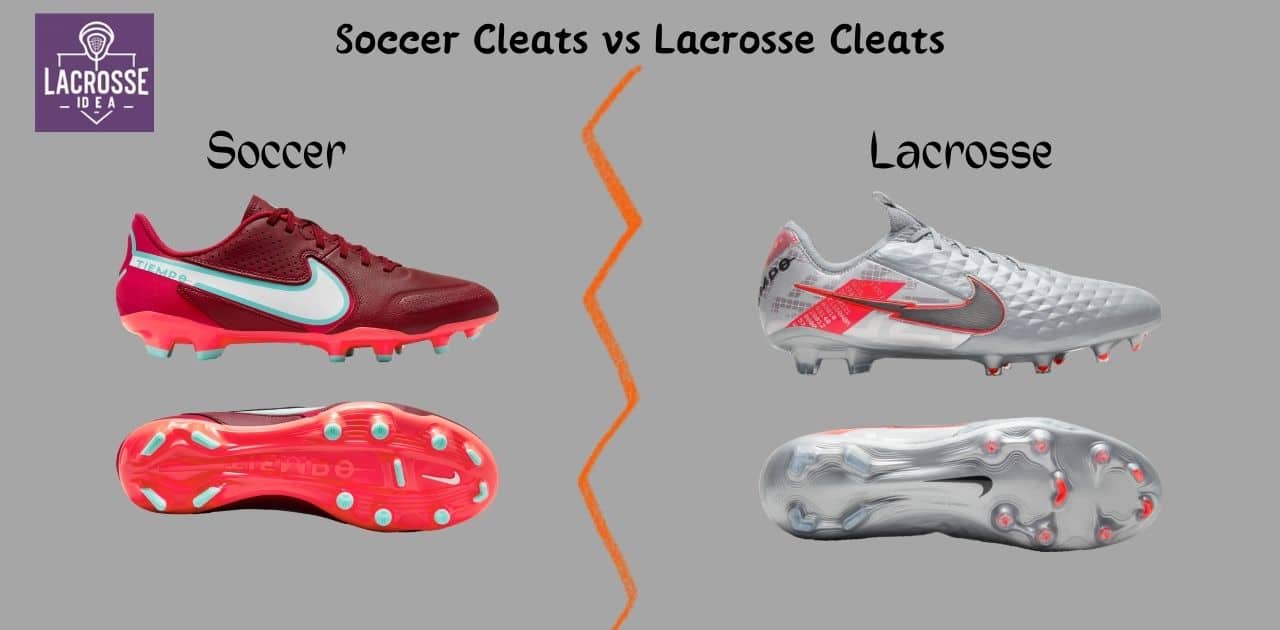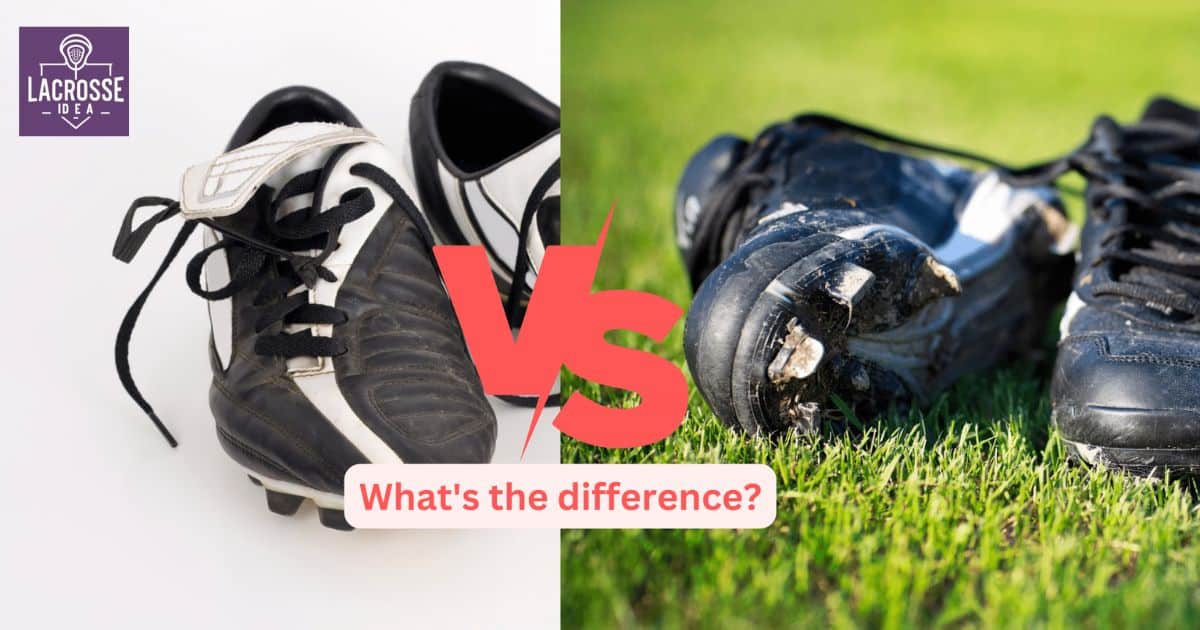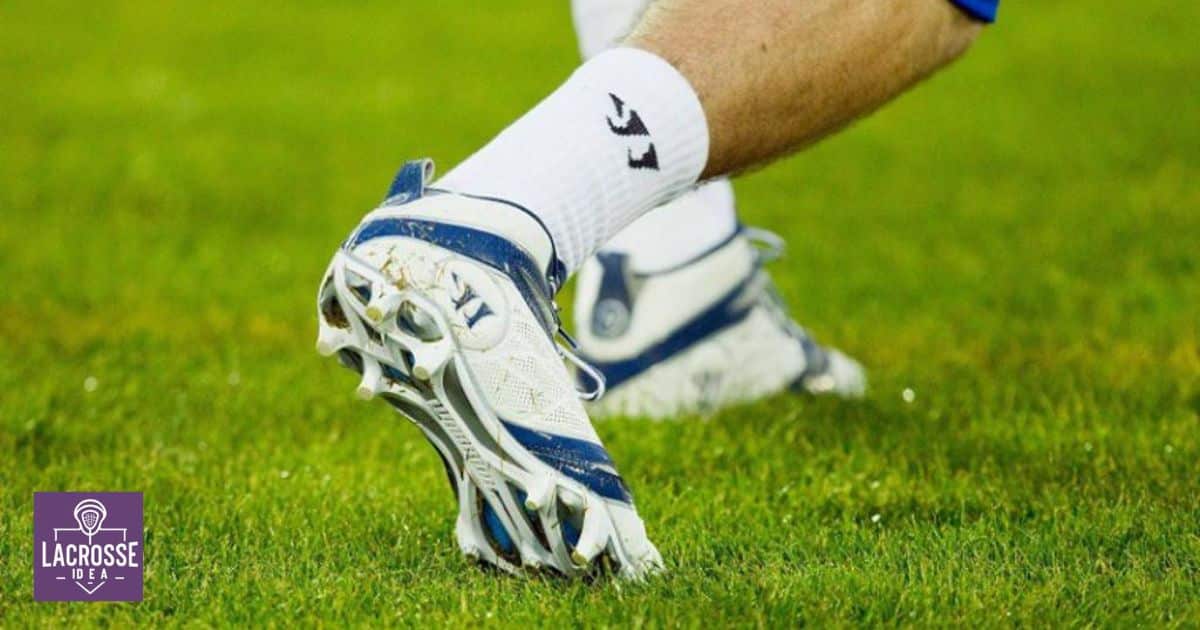Discover the decisive differences between soccer and lacrosse cleats in this insightful examination. In the world of lacrosse, can soccer cleats cut it? Uncover the truth as we delve into the crucial factors that separate these athletic shoes. From traction and grip to support and stability, we explore the paramount importance of proper footwear for lacrosse. Join us on this journey to ensure you make the right choice for your lacrosse footwear needs.
Key Takeaways
- Soccer cleats prioritize agility and speed, while lacrosse cleats focus on stability and ankle support.
- Lacrosse cleats offer superior traction on both grass and synthetic turf, while soccer cleats provide excellent grip on grass surfaces.
- Lacrosse cleats have features like sidewall stability and quick lateral movement support, while soccer cleats have a lightweight construction and a low-profile design.
- Lacrosse cleats are suitable for various surfaces, including artificial fields, while soccer cleats are primarily designed for grass fields.
Key Differences Between Soccer And Lacrosse Cleats
When comparing soccer cleats to lacrosse cleats, it is important to understand the key differences between the two types of footwear. One of the main distinctions lies in the traction differences. Soccer cleats are designed to provide excellent grip on grass surfaces, allowing players to maneuver quickly and make sharp turns. In contrast, lacrosse cleats are specifically engineered to offer superior traction on both grass and synthetic turf. This is because lacrosse is often played on a variety of surfaces, including artificial fields.
Another important aspect to consider is the performance benefits provided by each type of cleat. Soccer cleats prioritize agility and speed, with features like lightweight construction and a low-profile design. On the other hand, lacrosse cleats focus on stability and ankle support to accommodate the intense lateral movements required in the game. Understanding these differences will help players choose the appropriate cleats for their specific needs and enhance their performance on the field.
Importance Of Proper Footwear For Lacrosse
Proper footwear is crucial for lacrosse players, as it directly impacts their performance and reduces the risk of injuries. When it comes to lacrosse cleats, there are several key reasons why they are essential for the game:
- Traction benefits: Lacrosse cleats are designed with specialized soles that provide excellent traction on different playing surfaces. This ensures that players can make quick cuts, change directions, and maintain stability during intense gameplay.
- Performance advantages: Lacrosse cleats are specifically designed to enhance the performance of players. They offer superior ankle support, allowing for better stability and reducing the risk of sprains. Additionally, they provide optimal comfort, flexibility, and durability, enabling players to perform at their best throughout the game.
- Protection and safety: Lacrosse cleats offer reinforced toe caps and padded collars, providing added protection to the feet and ankles. This helps prevent injuries from collisions, tackles, and falls.
- Fit and comfort: Lacrosse cleats come in various sizes and widths, ensuring a proper fit for each player. This ensures comfort and reduces the risk of blisters and discomfort during long hours of gameplay.
- Style and team spirit: Wearing proper lacrosse cleats not only contributes to individual performance but also boosts team spirit and belonging. Matching cleats create a sense of unity and pride among teammates, fostering a positive team culture.
Traction And Grip: Soccer Cleats Vs. Lacrosse Cleats
When comparing traction and grip between soccer cleats and lacrosse cleats, it is important to consider the design differences, field surface compatibility, and sport-specific performance benefits. Soccer cleats typically have a greater number of smaller studs for maximum grip on grass surfaces, while lacrosse cleats often feature larger, more aggressive studs for traction on a variety of field conditions. Additionally, lacrosse cleats may have specialized features such as sidewall stability and quick lateral movement support, which are crucial for the dynamic movements required in the sport.
Cleat Design Differences
Lacrosse cleats and soccer cleats differ in their traction and grip capabilities, making them distinct in their suitability for specific sports. When comparing the cleat design of these two types, there are several key differences that affect performance on the field:
- Studs: Soccer cleats generally have shorter, more numerous studs to provide better traction on the grassy field, allowing for quick changes in direction. In contrast, lacrosse cleats have longer and fewer studs to provide stability on both grass and artificial turf.
- Outsole: Soccer cleats often have a flat outsole, allowing for better contact with the ball and precise movements. Lacrosse cleats, on the other hand, have a slightly raised outsole with more aggressive patterns, providing enhanced grip and traction.
- Toe Box: Lacrosse cleats typically have a reinforced toe box to withstand the demands of the sport, where players frequently make contact with the ground and opponents. Soccer cleats, however, may have a more flexible and thinner toe box for better ball control.
- Ankle Support: Lacrosse cleats commonly offer higher ankle support to protect against lateral movements and potential injuries. Soccer cleats typically have a lower cut to allow for more freedom of movement.
- Weight: Lacrosse cleats tend to be heavier, offering more stability and support for the physical demands of the sport. Soccer cleats are often lighter to promote agility and speed on the field.
Understanding these cleat design differences is crucial in choosing the appropriate footwear for each sport, as it directly impacts performance and safety.
Field Surface Compatibility
Soccer cleats and lacrosse cleats vary in their field surface compatibility, specifically in terms of traction and grip. When it comes to field conditions, lacrosse players need cleats that can provide optimal traction on various surfaces, including grass, turf, and sometimes even muddy or wet fields. Lacrosse cleats are designed with specialized studs or spikes that offer superior grip and stability, allowing players to make quick cuts, change direction, and maintain balance during intense gameplay.
On the other hand, soccer cleats are primarily designed for grass fields and may not provide the same level of traction on other surfaces. Therefore, when it comes to shoe selection, it is recommended for lacrosse players to invest in cleats specifically designed for the sport to ensure the best performance and minimize the risk of injuries. Moving on to the next section, let’s explore the sport-specific performance benefits of lacrosse cleats.
Sport-Specific Performance Benefits
Lacrosse cleats offer enhanced traction and grip compared to soccer cleats, ensuring optimal performance on various field surfaces. When it comes to sport-specific advantages and performance enhancement, lacrosse cleats have a distinct edge over soccer cleats. Here are some key reasons why:
- Aggressive Cleat Patterns: Lacrosse cleats are designed with aggressive patterns that provide superior grip and traction on grass or turf, enabling quick direction changes and explosive movements.
- Durability: Lacrosse cleats are built to withstand the intense demands of the game, with reinforced materials and sturdy construction that can endure rough terrain and repeated use.
- Ankle Support: Lacrosse cleats often feature higher ankle collars, offering better stability and support during lateral movements and sudden stops.
- Lightweight Design: Lacrosse cleats are lighter in weight, allowing players to move swiftly and efficiently without feeling weighed down.
- Flexibility: Lacrosse cleats are designed to provide flexibility, enabling natural foot movement and quick response times on the field.
Support And Stability: Soccer Cleats Vs. Lacrosse Cleats
When considering the support and stability offered by soccer cleats compared to their lacrosse counterparts, it is important to evaluate their effectiveness in various playing conditions. Cleat performance in terms of support and stability relies heavily on shoe construction. Soccer cleats are designed with a low-profile and lightweight construction, focusing on agility and quick movements on the field. These cleats typically feature a more narrow and snug fit, providing excellent traction and grip on firm ground.
On the other hand, lacrosse cleats are built with a higher ankle profile, offering additional support and stability during the rapid lateral movements common in the sport. The broader construction of lacrosse cleats allows for better balance and stability on different playing surfaces. As we transition into discussing durability and protection, it is important to consider how these features contribute to overall performance and player safety.
Durability And Protection: Soccer Cleats Vs. Lacrosse Cleats
The durability and protection offered by soccer cleats compared to lacrosse cleats can be assessed by examining their construction and materials. When it comes to durability, soccer cleats are typically designed to withstand the demands of the sport, featuring reinforced stitching and sturdy materials such as leather or synthetic materials. On the other hand, lacrosse cleats are built to endure the specific movements and conditions of lacrosse, with features like reinforced toe caps and ankle support.
In terms of protection, soccer cleats provide adequate protection for the foot and ankle, but lacrosse cleats often offer additional padding and support to withstand the physicality of the game. Furthermore, the cost comparison between soccer cleats and lacrosse cleats may vary, with soccer cleats generally being more affordable due to their wider availability.
Potential Risks And Injuries Of Using Soccer Cleats For Lacrosse
When using soccer cleats for lacrosse, there are potential risks and injuries that players should be aware of. One major risk is an increased likelihood of foot and ankle injuries due to the lack of support and stability provided by soccer cleats. Additionally, using soccer cleats may result in decreased traction on the field, making it harder for players to change direction quickly and potentially leading to slips and falls.
Foot And Ankle Injuries
Several potential foot and ankle injuries can arise from using soccer cleats for lacrosse, posing a significant risk to players. Lacrosse requires specific foot and ankle support, which may not be adequately provided by soccer cleats. Here are some common injuries that can occur:
- Sprained ankles: Soccer cleats may not provide enough stability for the lateral movements involved in lacrosse, increasing the risk of ankle sprains.
- Achilles tendonitis: The lack of appropriate cushioning and support in soccer cleats can put excessive strain on the Achilles tendon, leading to inflammation and pain.
- Plantar fasciitis: Soccer cleats may not offer sufficient arch support, which can contribute to the development of plantar fasciitis, a painful condition affecting the bottom of the foot.
- Stress fractures: The repetitive movements and high-impact nature of lacrosse can lead to stress fractures in the foot, especially when wearing cleats that don’t provide enough shock absorption.
- Turf toe: Soccer cleats may not have the necessary flexibility to prevent or reduce the risk of turf toe, a sprain of the big toe joint caused by hyperextension.
To prevent these common injuries, it is advisable to wear lacrosse-specific cleats that provide the required foot and ankle support.
Decreased Traction And Stability
Using soccer cleats for lacrosse can result in decreased traction and stability, leading to potential risks and injuries. Soccer cleats are designed for the specific needs of soccer players, with features that cater to the demands of the game such as quick changes in direction and agility on grass surfaces. However, when it comes to lacrosse, the requirements are different.
Lacrosse involves more lateral movements, quick stops, and starts, which puts additional strain on the footwear. Soccer cleats may not provide the necessary grip and support needed for optimal performance in lacrosse. This can lead to decreased traction, causing players to slip or lose balance during crucial moments of the game. Additionally, inadequate support can increase the risk of ankle sprains and other lower limb injuries.
To better understand the differences between soccer cleats and lacrosse cleats, let’s take a look at the table below:
| Soccer Cleats | Lacrosse Cleats |
|---|---|
| Designed for soccer | Specifically designed for lacrosse |
| Focus on agility and quick changes in direction | Emphasize lateral movements and stability |
| Studs or blades for traction on grass surfaces | Cleats or spikes for traction on various surfaces |
| May lack ankle support | Provide ankle support for added protection |
| Lightweight and flexible | Sturdy and durable for rough play |
It is important for lacrosse players to invest in the right footwear to avoid decreased performance and minimize the risk of injuries. Lacrosse cleats are specifically designed to meet the demands of the sport, offering superior traction, stability, and support.
Advantages Of Using Soccer Cleats For Lacrosse
Soccer cleats offer numerous benefits for lacrosse players, enhancing their performance and providing them with a competitive edge. When it comes to cleat performance and shoe selection, soccer cleats can be a great option for lacrosse players. Here are some advantages of using soccer cleats for lacrosse:
- Versatile traction: Soccer cleats are designed to provide traction on multiple surfaces, allowing players to navigate the field with ease and agility.
- Lightweight design: Soccer cleats are typically lighter in weight compared to other types of athletic shoes, enabling players to move swiftly and effortlessly on the field.
- Ankle support: Many soccer cleats offer excellent ankle support, reducing the risk of injuries during quick direction changes and intense movements.
- Durable construction: Soccer cleats are built to withstand rigorous use and provide long-lasting performance, making them a reliable choice for lacrosse players.
- Affordability: Soccer cleats are often more budget-friendly compared to specialized lacrosse cleats, making them a cost-effective option for players looking to maximize their performance without breaking the bank.
Disadvantages Of Using Soccer Cleats For Lacrosse
Although there are benefits to wearing soccer cleats for lacrosse, there are also some disadvantages to consider. While soccer cleats may provide traction on grass, they may not be as effective on the turf commonly used in lacrosse games. Additionally, soccer cleats are designed for a different type of movement, with a focus on quick stops and starts, whereas lacrosse requires more lateral and multidirectional movements. This can lead to a lack of stability and potential for injury when wearing soccer cleats.
To address these disadvantages, there are potential alternatives available. Lacrosse cleats are specifically designed to meet the demands of the sport, with features such as ankle support, multidirectional traction, and flexibility. Some recommended lacrosse cleat brands include Nike, Under Armour, and New Balance. These brands offer a range of options to cater to different playing styles and preferences. By investing in proper lacrosse cleats, players can enhance their performance and reduce the risk of injuries.
| Potential Alternatives | Recommended Lacrosse Cleat Brands |
|---|---|
| Lacrosse Cleats | Nike |
| Under Armour | |
| New Balance |
Making The Right Choice For Your Lacrosse Footwear
When considering the appropriate footwear for lacrosse, it is crucial to make an informed decision that aligns with the specific demands and requirements of the sport. While soccer cleats may seem like a viable option for lacrosse, it is important to weigh the pros and cons before making a decision.
Here are some factors to consider:
- Pros of using soccer cleats for lacrosse:
- They provide traction on grass fields, which can be beneficial for outdoor lacrosse games.
- They may offer good stability and support for quick cuts and changes in direction.
- Soccer cleats are often lightweight, allowing for agility and speed on the field.
- Cons of using soccer cleats for lacrosse:
- The lack of ankle support may increase the risk of injuries, especially in a fast-paced and physical sport like lacrosse.
- Soccer cleats may not offer the same level of grip on artificial turf or indoor surfaces.
- The design and construction of soccer cleats may not be optimized for lacrosse-specific movements and demands.
Ultimately, the choice of footwear can have a significant impact on performance and gameplay when playing lacrosse. It is important to carefully consider the pros and cons before deciding whether soccer cleats are suitable for this sport.
Frequently Asked Questions
Can I Wear Soccer Cleats for Lacrosse if I Already Have Them?
Yes, you can wear soccer cleats for lacrosse if you already have them. However, it is important to note that lacrosse cleats are specifically designed for the sport and may offer better traction and support.
Do Soccer Cleats Have Similar Traction to Lacrosse Cleats?
When comparing the traction of soccer cleats to lacrosse cleats, it is important to note that soccer cleats are not specifically designed for the unique demands of lacrosse. While they may provide some traction, they may not offer the same level of grip and stability as lacrosse cleats. It is recommended to use lacrosse cleats for optimal performance in the sport.
Will Wearing Soccer Cleats for Lacrosse Affect My Performance?
Wearing soccer cleats for lacrosse can have both positive and negative effects on performance. While soccer cleats provide traction and stability, they may lack the necessary support and durability required for the specific movements and demands of lacrosse.
Are There Any Specific Rules or Regulations Regarding Footwear in Lacrosse That I Should Be Aware Of?
In lacrosse, it is important to be aware of specific rules and regulations regarding footwear. Just as in other sports like football and basketball, there may be guidelines that could be applied to ensure safety and fair play.
Are There Any Alternative Options to Lacrosse Cleats if I Don’t Want to Invest in a New Pair?
Yes, there are alternative options to lacrosse cleats if you don’t want to invest in a new pair. However, it is important to consider the impact on performance as soccer cleats may not provide the necessary traction and support.
Conclusion
In conclusion, while it may be tempting to wear soccer cleats for lacrosse, it is important to consider the key differences between the two sports and the specific footwear requirements for lacrosse. Soccer cleats may offer advantages in terms of traction and affordability, but they lack the necessary support, stability, durability, and protection needed for the demands of lacrosse.
Ultimately, it is crucial to make the right choice and prioritize the appropriate footwear to minimize the risk of potential injuries and optimize performance on the lacrosse field. As the saying goes, “Choose the right tool for the job.”









